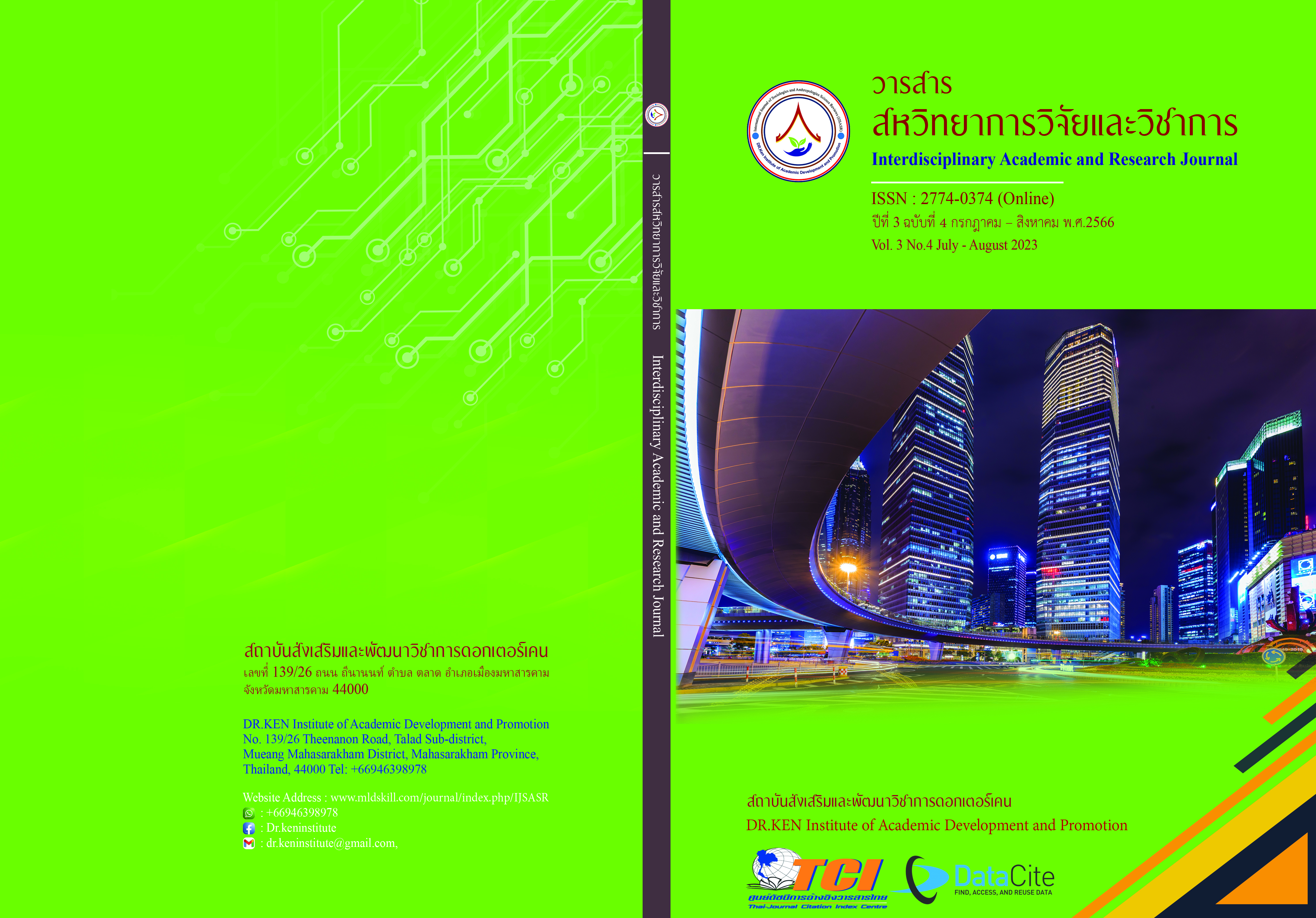Factor Analysis of Collaborative Working of Teachers in The New Normal
DOI:
https://doi.org/10.14456/iarj.2023.175Keywords:
Collaborative Working; , Factor Analysis; , The New NormalAbstract
Professional Learning Community (PLC) emphasizes the collaboration of administrators, teachers, and stakeholders in developing their own professional practice with fellow teachers. The exchange of knowledge, skills, and experiences necessary for professional development and professional knowledge. The current research endeavor aimed to investigate factors of collaborative working of teachers in the new normal era. The sample included 976 teachers working in private schools under the Office of the Private Education Commission in Bangkok’s subcenter 11 of the general education system in 2021. The research employed a 5-Likert scale questionnaire with an IOC value of 1.00 and a validity value of 0.950. The data were analyzed using EFA, orthogonal rotation, and varimax rotation. The research results revealed seven factors of collaborative working among teachers under the Office of the Private Education Commission in the new normal: self-awareness, compassion, online communication, self-adaptation, feedback, technological tools, and humility. Together these factors accounted for 67.175% of the variance. Moreover, it was also found that humility was the lowest mean among all components. Emphasis should be placed on encouraging teachers to reduce self-esteem in working with others. to create cooperation and unite in the work of teachers further efficiently.
References
กมลพร กัลยาณมิตร. (2564). การนำกลยุทธ์การบริหารสู่การปฏิบัติในรูปแบบความปกติใหม่ (New Normal). วารสารสังคมศาสตร์และมานุษยวิทยาเชิงพุทธ, 6(4), 402-422.
กรวิภา งามวุฒิวงศ์. (2559). ปัจจัยที่ส่งผลต่อการทำงานเป็นทีมภายในสำนักอำนวยการ สำนักงานปลัดกระทรวงศึกษาธิการ. วิทยานิพนธ์ปริญญามหาบัณฑิต: มหาวิทยาลัยธรรมศาสตร์.
กระทรวงศึกษาธิการ. (2564). ประกาศกระทรวงศึกษาธิการ เรื่อง นโยบายการจัดการศึกษาของกระทรวงศึกษาธิการ ปีงบประมาณ พ.ศ. 2564 – 2565. Retrieved from: https://moe360.blog/2021/06/30/education-management-policy/
กลุ่มพัฒนาสื่อ นวัตกรรมและเทคโนโลยีการศึกษา. (2559). คุรุสภา : PLC ชุมชนแห่งการเรียนรู้ทางวิชาชีพ (Professional Learning Community). Retrieved from: https://sites.google.com/a/esdc.go.th/kpt1-plc/home/plc1
ชณทัต บุญชูวงศ์. (2560). การศึกษาอิทธิพลของปัจจัยด้านการเรียนการสอนด้วยสื่อสังคมออนไลน์ ที่มีต่อการสื่อสารและการทำงานร่วมกันของนักศึกษาปริญญาบัณฑิต. วิทยานิพนธ์ปริญญามหาบัณฑิต: จุฬาลงกรณ์มหาวิทยาลัย.
ชนัญญา ใยลออ. (2560). การวิเคราะห์องค์ประกอบเชิงยืนยันการทำงานร่วมกันกับผู้อื่นในองค์กรธุรกิจขนาดกลางและขนาดย่อมตามแนวคิดความฉลาดทางวัฒนธรรม และแนวคิดอุปนิสัย 7 ประการของสตีเฟ่น อาร์โควี่. วารสารครุศาสตร์, 45(4), 37-55
ชัยชนะ มิตรพันธ์. (2563). ปรับไลฟ์สไตล์ชีวิตใหม่รับ New Normal หลังวิกฤตโควิด-19. Retrieved from: https://www.etda.or.th/content/new-normal-after-covid-19.html
ณัฏฐภรณ์ หลาวทอง. (2561). การพัฒนาสื่อเพื่อสร้างเสริมการเรียนรู้ที่สร้างสรรค์ เน้นความซื่อสัตย์ทางวิชาการของนักศึกษาในยุคดิจิทัล. คณะครุศาสตร์ จุฬาลงกรณ์มหาวิทยาลัย
เดือนเพ็ญ บุญลา และ ศิริพันธ์ ติยะวงศ์สุวรรณ. (2560). การพัฒนาแบบวัดการร่วมมือรวมพลังเชิงสถานการณ์ สำหรับนักเรียนชั้นมัธยมศึกษาตอนปลาย. วารสารราชพฤกษ์, 5(2), 111-117.
พัชราภรณ์ ดวงชื่น. (2563). การบริหารจัดการศึกษารับความปกติใหม่หลังวิกฤตโควิด–19. วารสารศิลปะการจัดการ, 4(3), 783-795
พิมพันธ์ เดชะคุปต์ และ พเยาว์ ยินดีสุข. (2563). การเรียนรู้เชิงรุกแบบรวมพลังกับ PLC เพื่อการพัฒนา. กรุงเทพมหานคร. สำนักพิมพ์จุฬาลงกรณ์มหาวิทยาลัย.
ภวิกา ภักษา. (2564). การรู้จักตัวตนบนสถานการณ์แห่งวิกฤต : โควิด-19. วารสารราชภัฏสุราษฎร์ธานี, 8(1), 104-118.
รุ่งชัชดาพร เวหะชาติ (2561). วิเคราะห์องค์ประกอบของชุมชนแห่งการเรียนทางวิชาชีพ (PLC). วารสารวิชาการ Veridian E-Journal บัณฑิตวิทยาลัย มหาวิทยาลัยศิลปากร, 11(3), 34-47.
วีรดนย์ หอมทอง และประสาท เนืองเฉลิม. (2562). การพัฒนาแนวทางการเสริมสร้างสมรรถนะครูด้านการงานเป็นทีมของสถานศึกษาสังกัดสำนักงานเขตพื้นที่การศึกษามัธยมศึกษา เขต 25. วารสารมหาวิทยาลัยราชภัฏร้อยเอ็ด, 13(3), 149–157.
สกุณา เกตนาวี, อลิษา ผาลิชัย, และมัทนา วังถนอมศักดิ์. (2565). การบริหารจัดการศึกษารับภาวะความปกติใหม่. วารสารวิชาการสถาบันพัฒนาพระวิทยากร, 5(3), 1-20.
สมพร ปานดำ. (2563). การประเมินโครงการการบริหารการจัดการเรียนการสอนออนไลน์ ในสถานการณ์การแพร่ระบาดของโควิด-19 วิทยาลัยอาชีวศึกษาเชียงราย. วารสารวิจัยและนวัตกรรมสถาบันการอาชีวศึกษากรุงเทพมหานคร, 5(1), 24-39.
สำนักงานกองทุนสนับสนุนการสร้างเสริมสุขภาพ (สสส.). (2564). ใส่ใจกันให้เป็นปกติเเบบ New Normal. Retrieved from: https://resourcecenter.thaihealth.or.th/interesting-issues.
สำนักงานคณะกรรมการส่งเสริมการศึกษาเอกชน. (2564). ข้อมูลจำนวนบุคลากรสังกัดสำนักงานคณะกรรมการส่งเสริมการศึกษาเอกชน. กรุงเทพฯ: สำนักงานคณะกรรมการส่งเสริมการศึกษาเอกชน
สำนักพัฒนาครูและบุคลากรการศึกษาขั้นพื้นฐาน. (2560). คู่มือการอบรมคณะกรรมการขับเคลื่อนกระบวนการ PLC (Professional Learning Community) “ชุมชนการเรียนรู้ทางวิชาชีพ”. Retrieved from: https://www.ben.ac.th/main/content/download/1/PLC.pdf
สุวิมล ติรกานันท์. (2553). การวิเคราะห์ตัวแปรพหุในงานวิจัยทางสังคมศาสตร์. กรุงเทพมหานคร : โรงพิมพ์แห่งจุฬาลงกรณ์มหาวิทยาลัย.
อานนท์ ธิติคุณากร. (2558). ความต้องการจำเป็นในการเสริมสร้างชุมชนแห่งการเรียนรู้ทางวิชาชีพของโรงเรียนกุหลาบวิทยา. An Online Journal of Education, 10(2), 562–575.
Caskey, M.M., & Carpenter, J. (2014). Building Teacher Collaboration School-wide. AMLE Magazine,
Dierdorff, E. C., Fisher, D. M., & Rubin, R. S. (2019). The Power of Percipience: Consequences of Self-Awareness in Teams on Team-Level Functioning and Performance. Journal of Management, 45(7), 2891–2919. https://doi.org/10.1177/0149206318774622
Ebel, R.L. (1972). Essentials of Educational Measurement. Upper Saddle River, NJ: Prentice Hall.
Gajda, R. (2004). Utilizing Collaboration Theory to Evaluate Strategic Alliances. American Journal of Evaluation. 25(1), 65-77.
Hair, J.F., Black, W.C., Babin, B.J., & Anderson, R.E. (2010). Multivariate Data Analysis: A Global Perspective. New Jersey America: Pearson.
Kaplan, M. (2021). Collaborative Team Teaching: Challenges and Rewards. Retrieved from: https://www.edutopia.org/blog/collaborative-team-teaching-challenges-rewards-marisa-kaplan
Morin, A. (2020). “What is Co-Teaching?”. Retrieved from: https://www.understood.org/en/learning-thinking-differences/treatments-approaches/educational-strategies/collaborative-team-teaching-what-you-need-to-know
Pepin, B., & Gueudet, G. (2020). Studying Teacher Collaboration with the Documentational Approach: From Shared Resources to Common Schemes? ICMI Study 25 - Teachers of Mathematics Working and Learning in Collaborative Groups, ICME, Feb 2020, Lisboa, Portugal. pp.158-165
Root, D. (2019). 7 Characteristics of a Truly Collaborative Workforce. Retrieved from: https://www.eagles flight.com/blog/7-characteristics-of-a-truly-collaborative-workforce.
Vangrieken, K., Dochy, F., Raes, E., & Kyndt, E. (2015). Teacher Collaboration: A systematic review. Educational Research Review, 15(3), 17-40, https://doi.org/10.1016/j.edurev.2015.04.002
Yamane, T. (1973). Statistics: An Introductory Analysis. 3rd Edition, New York: Harper and Row.
Downloads
Published
How to Cite
Issue
Section
License
Copyright (c) 2023 Weerasak Khotta, Chuthaphon Masantiah, Panida Panidvadtana

This work is licensed under a Creative Commons Attribution-NonCommercial-NoDerivatives 4.0 International License.
Copyright on any article in the Interdisciplinary Academic and Research Journal is retained by the author(s) under the under the Creative Commons Attribution-NonCommercial-NoDerivatives 4.0 International License. Permission to use text, content, images, etc. of publication. Any user to read, download, copy, distribute, print, search, or link to the full texts of articles, crawl them for indexing, pass them as data to software, or use them for any other lawful purpose. But do not use it for commercial use or with the intent to benefit any business.
















.png)


